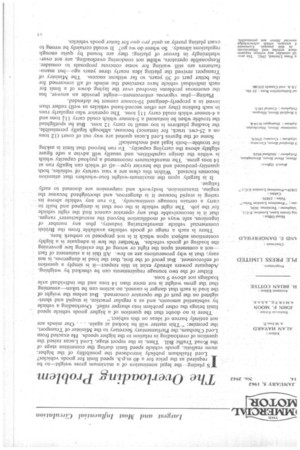The Overloading Problem
Page 39

If you've noticed an error in this article please click here to report it so we can fix it.
IS plating—the legal nomination of a maximum gross weight—to be required as the price for a 40 m.p.h. speed limit for goods vehicles? Lord Hailsharn publicly introduced the possibility of the higher, more realistic, goods vehicle speed limit during the committee stage of the Road Traffic Bill. Then, in the report stage, Lord Lucas raised the question of overloading in relation to the higher speeds. He exacted from Lord Chesham, the Parliamentary Secretary to the Minister of Transport, the promise: "This matter will be looked at again. . . . Our minds are not entirely barren of ideas on this subject."
There is no doubt that the question of a higher goods vehicle speed limit brings the other problem into sharper relief. Overloading a vehicle by substantial amounts, and as a regular practice, is stupid and shortsighted on the part of the operator concerned'. But unless the weight of the load is such that danger is caused, no action can be taken—assuming that the gross weight is not more than 14 tons and the individual axle loadings not above 9 tons.
Either of the two tonnage requirements can be checked by weighing. Adequate powers already exist in this respect—it is simply a question of enforcement. But proof of the first, that the load is dangerous, is not easy; that is why prosecutions are so few. All this is a statement of fact —not a comment upon the right or wrong of the existing law governing the loading of goods vehicles. Whether the law is adequate is a highly contentious subject upon which it is not proposed to embark here.
There is such a range of goods vehicles available from the British commercial vehicle manufacturing industry, plus any number of ingenious, safe ways of modification beyond the manufacturers' ruins, that it is inconceivable that any operator cannot find the right vehicle for the job. The right vehicle is the one that is designed and built to carry a certain tonnage continuously. To run any vehicle above its rating is stupid because it is dangerous, and shortsighted because the engine, transmission, bodywork and suspension are doomed to early fatigue. .
It is largely upon the maximum-weight four-wheelers that attention becomes focused. Within this class are a vast variety of vehicles, both quantity-produced and the heavier type--all of which can legally run at 14 tons gross. The manufacturers recommend a payload capacity which is within the design capabilities, and usually will advise a safe figure slightly above the carrying capacity. To run beyond that limit is asking for trouble—both legal and mechanical!
Some of the figures Lord Lucas quoted are way out of court (12 tons on a 25-cwt. truck, for instance) because, although legally permissible, the loading platform is too small to carry 12 tons. But he spotlighted the trouble when he instanced a 5-tonner which could carry 114: tons and a 4-tonner which could carry ill; tons. The operator who regularly runs in such fashion (they are often second-hand vehicles as well) rather than invest in a properly-designed 10-toriner cannot be defended.
Plating—plus vigorous enforcement—might provide an answer, but the enormous problems involved over the laying down of a limit for each individual vehicle have exercised the minds of all concerned for the better part of 30 years, so far without success. The Ministry of Transport revived the plating idea nearly three years ago—but manufacturers are still waiting for some concrete proposals to consider. Responsible operators, whilst not condoning overloading, are not overwhelmingly in favour of plating; they are bound by quite enough regulations already. So where do we go? It would certainly be wrong to exact plating purely as quid pro quo for faster goods vehicles.




























































































































